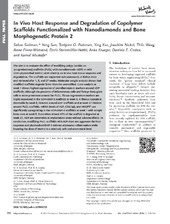In vivo host response and degradation of copolymer scaffolds functionalized with nanodiamonds and bone morphogenetic protein 2
Suliman, Salwa; Sun, Yang; Pedersen, Torbjørn Østvik; Xue, Ying; Nickel, Joachim; Waag, Thilo; Finne-Wistrand, Anna; Steinmüller-Nethl, Doris; Krueger, Anke; Costea, Daniela Elena; Mustafa, Kamal Babikeir Eln
Peer reviewed, Journal article
Published version

Åpne
Permanent lenke
https://hdl.handle.net/1956/15338Utgivelsesdato
2016-03Metadata
Vis full innførselSamlinger
Originalversjon
https://doi.org/10.1002/adhm.201500723Sammendrag
The aim is to evaluate the effect of modifying poly[(l-lactide)-co-(ε-caprolactone)] scaffolds (PLCL) with nanodiamonds (nDP) or with nDP+physisorbed BMP-2 (nDP+BMP-2) on in vivo host tissue response and degradation. The scaffolds are implanted subcutaneously in Balb/c mice and retrieved after 1, 8, and 27 weeks. Molecular weight analysis shows that modified scaffolds degrade faster than the unmodified. Gene analysis at week 1 shows highest expression of proinflammatory markers around nDP scaffolds; although the presence of inflammatory cells and foreign body giant cells is more prominent around the PLCL. Tissue regeneration markers are highly expressed in the nDP+BMP-2 scaffolds at week 8. A fibrous capsule is detectable by week 8, thinnest around nDP scaffolds and at week 27 thickest around PLCL scaffolds. mRNA levels of ALP, COL1α2, and ANGPT1 are significantly upregulating in the nDP+BMP-2 scaffolds at week 1 with ectopic bone seen at week 8. Even when almost 90% of the scaffold is degraded at week 27, nDP are observable at implantation areas without adverse effects. In conclusion, modifying PLCL scaffolds with nDP does not aggravate the host response and physisorbed BMP-2 delivery attenuates inflammation while lowering the dose of BMP-2 to a relatively safe and economical level.
